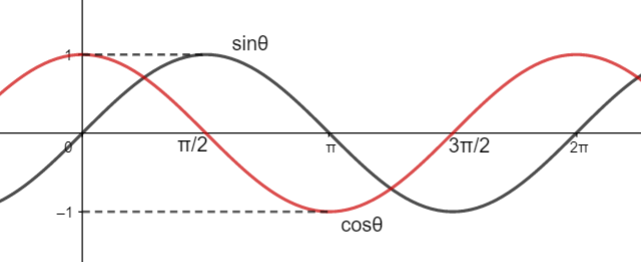Question
Question: The maximum value of \(\sin \theta +\cos \theta \) is A. 1 B. 2 C. 3 D. \(\sqrt{2}\)...
The maximum value of sinθ+cosθ is
A. 1
B. 2
C. 3
D. 2
Solution
Hint: We will find the derivative of the given function sinθ+cosθ and equate the result of the first derivative with zero to get the critical point. In the final step we will find the second derivative of the function and find out if it is positive, negative or zero to get the maximum value of the function. If f′′(x)<0, then it is the positive point.
Complete step-by-step answer:
In the question, we have been given f(x)=sinθ+cosθ and we have to find the maximum possible value for this function. We will use the derivative method to solve this question. In the derivative method, we will find the derivative of the given function by differentiating it. In the next step we will equate the result of the first derivative with zero to get the critical point. (Critical point is the point on which the function equates to zero) In the third step we will find the second derivative of the given function and check if it is positive or negative. If the value of the second derivative is less than zero, then it is the maxima point of the function and if the value is greater than zero, then it is the minima point of the given function.
f′′(x)<0 (maxima)
f′′(x)>0 (minima)
On differentiating the given function f(x), we get,
f(x)=sinθ+cosθ
We know that dθd(sinθ)=cosθ
And, dθd(cosθ)=−sinθ
So, we get f′(x)=cosθ−sinθ
Now, we will equate f′(x) with zero to get the critical point.
cosθ−sinθ=0
On dividing both sides by cosθ, we get,
cosθcosθ−cosθsinθ=01−tanθ=0−tanθ=−1tanθ=1
We know that the value of θ at which the value of tanθ=1 is 45∘. So, we get θ=45∘.
It means the critical point of the function is 45∘.
Now, we will check if the given function sinθ+cosθ is the maxima or minima at that point. By double differentiating the function, we get,
f′(x)=cosθ−sinθf′′(x)=dθd(cosθ)−dθd(sinθ)f′′(x)=−sinθ−cosθ
Taking -1 common from RHS, we get,
f′′(x)=−(sinθ+cosθ)
Now, we will check if f′′(x) is greater or smaller than zero.
−(sinθ+cosθ)<0⇒f′′(x)<0
Which means that θ=45∘ is the point of maxima because f′′(x)<0. So, x=45 is the point of maxima. Hence the maximum value of the function f(x) at x=45∘ is,
=sin45∘+cos45∘=21+21=22=2
Therefore the maximum value of f(x)=sinθ+cosθ is 2 and option D is the correct answer.
Note: The value of cosθ and sinθ lie between -1 and 1. We can represent it graphically as shown below,

The value of sinθ will increase from 0 to 2π and the value of cosθ will decrease from 0 to 2π.
Thus the maximum value of sinθ+cosθ will lie only in the first quadrant at 45∘.
f(x)=sinθ+cosθ=sin45∘+cos45∘=21+21=22
